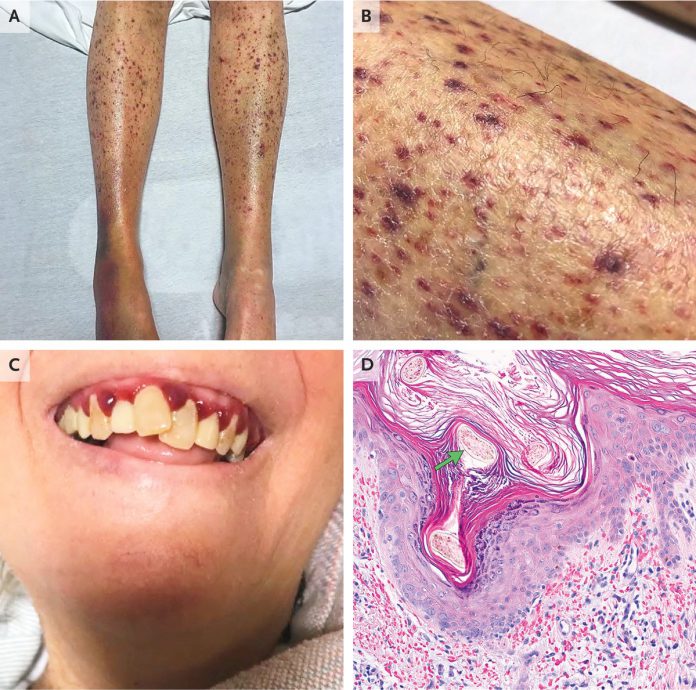A clue to diagnosis
A vitamin that the human body doesn’t store, abundant in the diet, and rarely seen to be deficient!
Here is a case of a 72-year-old woman who came to the emergency department with a history of bleeding from gums for 6 months and rash on both her legs for the past 3 months. The patient also reports poor oral intake attributable to the diagnosis of esophageal strictures made approximately 2 years back.
The inspection of her oral cavity revealed gingival bleeding (Panel C). On physical examination of her legs, perifollicular petechiae, follicular hyperkeratosis, and corkscrew hairs, in addition to red and blue ecchymoses on both ankles (Panels A and B) were observed.
A skin sample was obtained from a leg lesion for histopathological evaluation which revealed a corkscrew hair (Panel D, arrow) with perifollicular hemorrhage.
Scurvy was suspected
Levels of serum ascorbic acid confirmed the diagnosis as the patient had less than 5 μmol per liter in her plasma (0.1 mg per deciliter; reference range, 23 to 114 μmol per liter [0.4 to 2.0 mg per deciliter]).
Treatment was started with ascorbic acid supplement 500 mg, peroral, daily for 3 months.
Decreased levels were highly attributable to the poor nutritional status of the patient; therefore, to manage the complaints of poor oral intake, it was mandatory to address the esophageal strictures.
Serial esophageal dilations were performed to manage the esophageal strictures. Thereafter, the patient’s oral intake resumed to normal, and at the 4-month follow-up, the symptoms of scurvy had resolved.
Scurvy is a very rare diagnosis. It is a severe vitamin C deficiency, but its clinical features are quite similar to bleeding and vessel disorders; therefore, patients are first extensively evaluated for other diagnoses before making a definitive diagnosis of scurvy.
Human bodies neither store nor synthesize vitamin C; instead, they absorb ascorbic acid from the intestines. Thus, the main source is the diet containing citrus fruits and vegetables such as oranges, lemons, limes, potatoes, broccoli, spinach, etc. Inadequate intake for up to 12 weeks can lead to clinical manifestations of vitamin C deficiency.
It is not only imperative to intake nutritious food, but it is equally crucial to know that ascorbic acid (vitamin C) is highly sensitive to heat, so cooking, storage, and oxidation may destroy the vitamin C content.
Alcoholism and poor dietary choices are the leading causes of deficiency in healthier individuals. However, other important causes include psychiatric disorders, including eating disorders, intestinal malabsorption syndromes, and patients with chronic kidney disease undergoing hemodialysis.
Scurvy is readily reversible with vitamin C intake
The non-specific symptoms improve within 24 hours, the vascular symptoms including, bruising and gingival bleeding, improve in approximately 2 weeks, and hair growth becomes normal in approximately 4 weeks. However, complete recovery should be expected anywhere between 1 and 3 months.
The management of patients with scurvy is primarily dependent upon educating the patients and replenishing vitamin C.
Educate the patient regarding the importance of diet. 1 to 2 grams of vitamin C is recommended for the first 2 to 3 days, followed by 500 mg per day for the next week. Thereafter, supplementation should be continued up to 3 months with a daily dose of 100 mg of vitamin C.
Bottom line: Eat right!
References
Malan Kern, M. a. (2020, May 14). Mucocutaneous Manifestations of Scurvy. Retrieved from The New England Journal of Medicine: https://www.nejm.org/doi/full/10.1056/NEJMicm1911315
Léger D. (2008). Scurvy: reemergence of nutritional deficiencies. Canadian family physician Medecin de famille canadien, 54(10), 1403–1406.




